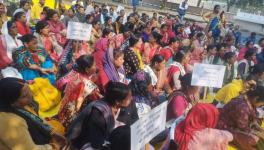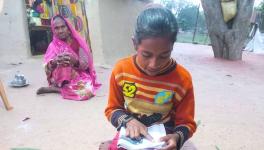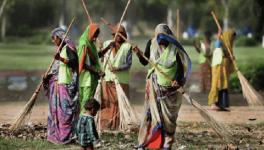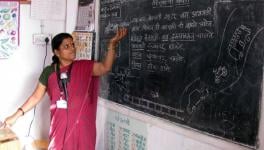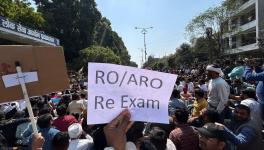Khapitalism Today
We tend to think of Haryana today as the home of “honour” killings, gang rapes, domestic violence, violence against Dalit, violence against workers and trade unions.
There is a shade of truth in these assumptions; but Haryana is also the setting of inspiring stories of resistance. This is, all too often, overlooked by the mainstream media.
Keeping this in mind, the notorious Khap Panchayats of Haryana also need to be understood in terms beyond the usual clichés of “India’s Taliban” and “medieval justice”. Whether it is the Taliban shooting Malala for demanding the right of girls to education, or whether it is Khap Pradhans suggesting that the marriageable age of girls be reduced to 15 as a “solution” to the problem of rapes, what is apparent is deeply ingrained misogyny in South Asia. What scares both Khaps and Taliban is the independence of women.
This fear is behind the Khap threat: if young women do not fall in line, if they want to be “independent”, they must expect rape or worse as the instrument of segregation. The call to “marry them off at 15” once again shows the desperation of the Chowdharys from the dominant caste – clearly they are unable to contain growing resistance from women and marginalized communities. This complex of misogyny, social churning and resistance at many levels -- transgressions from societal norms, a rejection of the dominance of gender and caste hierarchies – is at the core of the violence in Haryana today. The violence against women and “lower” castes indicate more than caste revivalism; they comprise a measure of growing resistance against patriarchy as well as entrenched hierarchies of caste dominance.
A section of the dominant caste, the Jats, are being organized on a range of regressive issues -- from demanding Jat reservations and protesting the Mirchpur case being transferred to a Delhi Court to demanding an amendment to the Hindu Marriage Act to ban same-gotra marriages. Over the last couple of years, agitations by sections of Jats on such issues have often brought the state to a standstill. The crowds in these agitations are frequently led by the same people --- Khap Pradhans, leaders of Mirchpur committees or leaders of the myriad “Jat Arakshan Samitis”. Not surprisingly, many of them are local leaders of either the Congress or Chautala’s India National Lok Dal.
How have the Khaps arrived at this point of an almost inescapable force? After independence, they were almost defunct in Haryana, with a role restricted to a notional reverence for the mostly dynastic Khap Pradhans. There was little or no decision-making authority. An outsider travelling across the state, even ten or fifteen years back, may have found that most young people had not even heard of the Khaps. Then, with caste revivalism, politically influential and ambitious Jat landlords hopped on to the Khap bandwagon. They became self-appointed Pradhans and Maha Sachivs of various Khaps. Self-choice marriages, especially when inter-caste, became the lathi to police and maintain existing caste hierarchies, control the sexuality of women in the guise of morality; and uphold patriarchal structures in the name of tradition.
Meanwhile, a section of the Jat youth was left with little or no land-ownings over the years, partly because of land fragmentation. At the same time, unemployment increased. For unemployable youth with little access to cultural or other forms of expressions, an “identity” became possible in caste-based lumpenism. Finding themselves at par economically with the Dalits in their villages, these youth aligned themselves with Khaps in a desperate attempt to assert their dominant caste identity. The lumpen youth muscle power the Khaps project as their overwhelming support base emerge from such socio-economic realities.
The Khaps have propagated their own myths to counter critical reports in the media. But despite their critical stance, the national media in general, and the English media in particular, have unknowingly helped reinforce some of the myths the Khaps have constructed. Initially, many in the media believed the Khap myth that they were only opposed to same-gotra and same-village marriages. Some even claimed that they weren’t opposed to inter-caste marriages as long as both partners weren’t from the same or neighbouring villages. The shrill, emotive cries against same-gotra marriages do find some resonance among the Jat communities. But there have been barely one or two same-gotra marriages in the state. What then is the real issue?
Ironically, the Manoj-Babli case, the first case filed by a family against an “honour” killing in Haryana, concerned a same-gotra marriage. Manoj’s widowed mother, Chandrapati, and his sister, Seema, along with the women’s organization AIDWA, continue to fight a heroic legal battle against the Khaps, and indeed the entire state machinery. This case brought the Khaps into the limelight. It also gave them that all important issue of same-gotra marriages. This was rendered more respectable with the help of pseudo-science to equate same-gotra marriages and consanguineous marriages.
On the ground, the real opposition lay elsewhere. In 2009, the Banwala Khap leaders in Jind district openly issued a diktat to kill Vedpal for marrying Sonia. Sonia-Vedpal belonged to neighbouring villages – the two were neither from the same-gotra nor the same village. In the Poonam-Surinder marriage in Bhiwani in 2006, there was no question of violating any kinship or gotra norms since the couple belonged not only to different gotras but also different castes. Surinder, a Dalit boy, married a Jat girl. Their marriage, representing the biggest threat to the Khaps, provoked the Sheoran Khap to use vile methods – including kidnapping the girl from her house -- to break the marriage.
In agrarian communities like the Jats, land is the most coveted property. Young women are seen as conduits of land and property. Inter-caste marriages (particularly when the girl is of a higher caste) and marriages of couples from villages with geographical proximity, are considered the most contentious. If young women can assert their right to marry the man of their choice, they may also assert their legal right over their share of ancestral property. This is the underlying fear that dictates the need to control their marriages and get them married to men from distant villages. In the case of inter-caste marriages the fear is sharper, with the possibility of land, property and wealth -- and hence power -- being shared with transferred to a family of a lower, or at any rate different, caste.
While working on my film, “Izzatnagariki Asabhya Betiyaan” my team and I went to an all-girls government school in a village in Hissar district to talk to some of the senior girls. When I think back on this visit, I am amused by our naiveté. We were just three young men; the absence of a woman in our crew on that day made breaking the ice tougher. But after some initial shy responses to our questions about self-choice marriages, young Aarti and Nancy mustered up their courage. Aarti went on to talk about the myopia of the Khaps in suggesting that girls be married off at 15. ”If a girl is put under restrictions, she will be sent from one form of confinement to the other --- from her parent’s house to that of her in-laws”. She went on to speak about how girls felt stifled at home and dream of the kind of independence boys have. She said girls wouldn’t elope if they felt liberated, because somewhere that’s what they seek when they elope with someone of their choice. Her fists clenched as she spoke in almost in one breath. Once she was done, she looked down, as if an equal measure of relief and fear overwhelmed her. Many in the class nodded vigorously as she spoke. It was as if Aarti had given them all a voice.
Many Aartis are speaking up today, whether in words or action. Stories of individual resistance have become commonplace in Haryana. Because of increasing awareness of their democratic rights, young girls (and even boys) continue to make such choices despite the consequences. This has opened the floodgates for change -- a change that is beginning to shake the very foundations of a society in the grip of the caste panchayats led by the Chowdharys. This change is the context in which Jai Singh Ahlawat, the Pradhan of the Ahlawat Khap, sums up what irks the Khaps most. In the film “Izzatnagari Ki Asabhya Betiyaan”, he says: “The biggest threats to our traditional codes are the educated youngsters and Dalit officers who want everything to be equal and our age-old customs to die out... And, of course, our immoral daughters who reduce themselves to animals with all their talk of equality…”..."
The Khaps know that there is a change; they also know that this is linked to a growing organized resistance. Progressive women’s groups in Haryana, particularly the AIDWA, have taken on Khap diktats as well as a range of issues around gender discrimination. When the Khaps gathered in Jind on the April 24, 2011 to protest the Supreme Court decision pronouncing Khaps illegal, they expressed their ire not only at the judiciary but also AIDWA. They promised to “strengthen the struggle against Mahila Samiti“(AIDWA).
AIDWA has successfully intervened in several cases in which the Khaps tried to break “contentious” matrimonial alliances; AIDWA has built on their interventions to initiate a movement. Dynamic leaders of the Haryana AIDWA, such as Jagmati Sangwan and Shakuntala Jakhar, live under constant threat, and their bravery in continuing their work is laudable. Neighbouring states such as Punjab and Western U.P. see an equal amount if not worse cases of “honour” killings; but those in Haryana are visible precisely because of the organized struggle of women’s organisations such as AIDWA. It is telling that Haryana’s Chief Minister Bhupinder Singh Hooda considers such women’s organisations “unnecessary” rabble rousers.
Consider, for example, the massive rally organized by AIDWA at Rohtak on October 15th this year. The rally was held to protest growing incidents of violence against women, particularly the recent spate of rape cases. It was heartening to see an impressive mobilization and that people from various progressive organizations from Rajasthan, Delhi and Punjab also attended the rally to express their solidarity.
The state government played a very different role. It deployed armed police personnel, barricades, water cannons and tear-gas guns to quell the crowd. The protesters (mainly women, including family members of the rape victims) were lathi charged and five of them were seriously injured. 400 social activists were booked on charges of “preventing officials from discharging duties and assaulting policemen”. Both the CM and his representatives refused to meet the delegation of the women's organisations. (The CM is always ready to meet the Khap representatives, but couldn’t spare half an hour for a delegation with a charter of demands to ensure the safety of women in his state.)
In a desperate attempt to save face, Hooda colluded with the Khaps to organize a Maha Panchayat on the issue of sex selective abortions, and publicly announce their resolve to fight it. The CM doled out a cheque of one crore rupees to the Khaps to wage their struggle against sex selective abortions. Though this was supposed to be an “all-women’s Khap”, but spoiled by habit, the Chowdharys couldn’t help but foreground themselves. The majority of the speakers were men from different Khaps. One of the few women speakers spoke about the need to recognize the importance of the inheritance of land and property by women to tackle the declining sex ratio. She was silenced.
With the real estate boom, erstwhile landlords have become billionaires overnight and the land has become even more valuable. Corporate capitalism and the real estate boom have combined to help revive slowly decaying feudal structures; feudal lords have been given a shot in the arm by their new found wealth. In fact, the growth of property dealers and Khap Panchayats in Haryana has been almost simultaneous. The Khap Panchayats are strongest in Jhajjar, Rohtak, Sonepat, Panipat and Western U.P. -- districts around Delhi which have been the biggest gainers from the recent real estate boom.
It is hardly surprising then that the Khaps have the support of Haryana’s industrialist politician Naveen Jindal. The Khap-industrialist arrangement is reciprocal. For example, the Khaps came out in large numbers to support the Maruti management in Manesar during the recent violent events involving labour. Capitalism and feudalism have thus formed a strange alliance which finds the two partners in perfect harmony.
The uneasiness over losing the dominant caste status has become clearer. The desperation to reverse this loss manifests itself in “honour” crimes and in a multitude of attacks on Dalits over the last decade. The more prominent incidents range from the burning down of the Dalit bastis in Mirchpur and Gohana, and the killing five Dalits in Jhajjar; Dalits have been subjected to socio-economic boycotts; Dalits have been banished from villages like Kyodad and Harsola in Kaithal district. The Khap reaction to these atrocities is significant. In every one of these cases, they have stood by the perpetrators; indeed, in some cases, they are themselves the perpetrators. They also tried to hoodwink the public by manipulating facts; one of the more absurd examples is their suggestion that the Dalits in Mirchpur burnt down their own houses to claim compensation.
As the socio-economic churning in Haryana grows, so does the list of enemies of the Khaps -- from women’s organisations to Dalits, from cell phones to chowmein. In response, the Khap forms alliances with the state and with capital.
The struggle against the Khaps has to be waged by an equally united front – consisting of women and Dalit organisations to trade unions and progressive groups. All must come together in the fight against this manifestation of corporate crony capitalism and violent feudalism. As Marx had once famously pronounced, “Force is the midwife of every old society pregnant with a new one.”
The unmarried 15 year old girls of Haryana seem to have decided where they are headed. It’s for the rest of us to support and follow.
Get the latest reports & analysis with people's perspective on Protests, movements & deep analytical videos, discussions of the current affairs in your Telegram app. Subscribe to NewsClick's Telegram channel & get Real-Time updates on stories, as they get published on our website.










